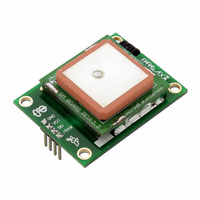28146 Parallax Inc, 28146 Datasheet - Page 5

28146
Manufacturer Part Number
28146
Description
MODULE RECEIVER PARALLAX GPS
Manufacturer
Parallax Inc
Datasheet
1.28146.pdf
(11 pages)
Specifications of 28146
Frequency
1.575GHz
Sensitivity
-139dBm
Modulation Or Protocol
GPS
Applications
GPS
Current - Receiving
115mA
Data Interface
PCB, Through Hole
Antenna Connector
On-Board, Chip
Voltage - Supply
4.5 V ~ 5.5 V
Operating Temperature
-40°C ~ 85°C
Package / Case
Module
Product
Microcontroller Accessories
Lead Free Status / RoHS Status
Lead free / RoHS Compliant
Features
-
Memory Size
-
Data Rate - Maximum
-
Lead Free Status / Rohs Status
Lead free / RoHS Compliant
DC Characteristics
At V
Parameter
Supply Voltage
Supply Current, Active
GPS Technology Brief
Some material in this section is based on information provided by the Global Position System FAQ
(http://www.gpsy.com/gpsinfo/gps-faq.txt)
Developed and operated by the United States government, GPS (Global Positioning System) is a
worldwide radio-navigation system formed by a constellation of 24 satellites and their ground stations.
With an unobstructed, clear view of the sky, GPS works anywhere in the world, 24 hours a day, seven
days a week.
The Global Positioning System consists of three interacting components:
1) The Space Segment -- satellites orbiting the earth.
2) The Control Segment -- the control and monitoring stations run by the United States Department
of Defense (not discussed in this documentation).
3) The User Segment -- the GPS signal receivers owned by civilians and military.
The space segment consists of a constellation of 24 active satellites (and one or more in-orbit spares)
orbiting the earth every 12 hours. Four satellites are located in each of six orbits and will be visible
from any location on each 95 percent of the time. The orbits are distributed evenly around the earth,
and are inclined 55 degrees from the equator. The satellites orbit at an altitude of about 11,000
nautical miles.
Each satellite transmits two signals: L1 (1575.42 MHz) and L2 (1227.60 MHz). The L1 signal is
modulated with two pseudo-random noise signals - the protected (P) code, and the course/acquisition
(C/A) code. The L2 signal only carries the P code. Civilian navigation receivers only use the C/A code
on the L1 frequency. Each signal from each satellite contains a repeating message, indicating the
position and orbital parameters of itself and the other satellites (almanac), a bill of health for the
satellites (health bit), and the precise atomic time.
The receiver measures the time required for the signal to travel from the satellite to the receiver, by
knowing the time that the signal left the satellite, and observing the time it receives the signal, based
on its internal clock. If the receiver had a perfect clock, exactly in sync with those on the satellites,
three measurements, from three satellites, would be sufficient to determine position in three
dimensions via triangulation. However, that is not the case, so a fourth satellite is needed to resolve
the receiver clock error. With four satellites, a GPS receiver can provide very accurate clock (time,
date) and position information (latitude, longitude, altitude, speed, travel direction/heading).
Note that position data and accuracy are affected or degraded by the satellite geometry,
electromagnetic interference, and multipath, an unpredictable set of reflections and/or direct waves
each with its own degree of attenuation and delay. Primarily due to satellite geometry, measuring
CC
= +5.0V and T
A
= 25ºC unless otherwise noted
Symbol
V
I
CC
CC
Conditions
---
---
Test
Parallax GPS Receiver Module * Revision 1.1
Min.
4.5
80
Specification
Typ./
Avg.
115
5.0
Max.
135
5.5
Page 5/11
Unit
mA
V




















